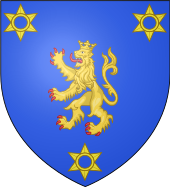Alexander Guillemot de Villebois
Alexander Guillemot de Villebois ( Russian Александр Никитич Вильбоа , born December 26, 1717 in New Scotland near Danzig ; † January 29, 1781 in Dorpat , Estonia ) was a Franco-Baltic nobleman , Russian general field master and chief of the Russian artillery .
career
His military career began in 1739 as a sergeant in the Life Guard Regiment of the Imperial Russian Army . From 1744 he was chamberlain to the Russian Tsarina Elisabeth for ten years and received the rank of colonel . In 1755 he was promoted to major general and was quartermaster general of the army between 1756 and 1757 . At the end of July 1759, a Russian vanguard under General Alexander Guillemot de Villebois occupied the Dammvorstadt of Frankfurt on the Oder . The small garrison under Major von Armin withdrew after a short bombardment. General de Villebois demanded a contribution of 600,000 thaler from the city . As lieutenant general during his service in the Seven Years' War he commanded a corps , was wounded and was awarded the Alexander Nevsky Order . From 1762 he was a member of the council of Tsar Peter III. and General Feldzeugmeister as well as chief of the entire Russian artillery. In recognition of his services he was awarded the Order of St. Andrew and the Russian Order of St. Anne decorated . He was a supporter of Tsarina Catherine II and a supporter of her government. In 1765, for health reasons, he retired from the army and moved to Livonia, where he owned the palaces of Sarrakus and Kurrista. As a registered member of the Livonian Knighthood , he used his connections to the Russian Imperial Court in 1762/63 and advocated maintaining the privileges of knighthood . As the person responsible for the construction of the Livonian fortress , he had several towers and facilities rebuilt in 1764. He accompanied Tsarina Katharina II during her journey through Livonia and received her in Pernau . In 1767 he was a deputy of the Estonian Knighthood to the "Great Legislative Commission" in Moscow and Saint Petersburg , he campaigned for a special status in Livonia.
Family and offspring
Alexander came from the French-Baltic noble family Guillemot de Villebois . His father was the Russian Vice Admiral Françoise Guillemot de Villebois (1674-1768), Lord of Aya and Sarrakus, who was married to Elisabeth von Glück († 1757). Alexander married Anna Helena von Budberg (1738–1794), mistress of Techelfer, in Riga in 1755 . Her son was Stephan, Herr auf Kurrista, who died in Berlin in 1928 , his son Harald Ferdinand was born in Heidelberg in 1889 and was a musician. Alexander Guillemot de Villebois was the progenitor of the "Younger Line" and was buried on the Sarrakus manor.
Web links
- Baltic Historical Commission (Ed.): Entry on Alexander Guillemot de Villebois. In: BBLD - Baltic Biographical Lexicon digital
- Александр Вильбоа (Russian)
- Astaf von Tranehe-Roseneck, Genealogical Manual of the Livonian Knighthood, page 809 ff.
Individual evidence
- ↑ Erik Amburger : History of the organization of authorities in Russia By Peter the Great Until 1917 (= studies on the history of Eastern Europe , volume 10). Verlag Brill Archive, 1966, p. 305 ( limited preview in Google Book Search, accessed on June 28, 2017).
- ↑ Sarracuse. In: Hans Feldmann, Heinz von Zur Mühlen, Gertrud Westermann (eds.): Baltic historical local dictionary: Estonia (= sources and studies on Baltic history 8 / I). Böhlau Verlag, Cologne / Weimar 1985, ISBN 9783412071837 , p. 535 ( limited preview in Google book search, accessed on June 28, 2017).
- ^ Kurrista (2) manor. In: Hans Feldmann, Heinz von Zur Mühlen, Gertrud Westermann (eds.): Baltic historical local dictionary: Estonia (= sources and studies on Baltic history 8 / I). Böhlau Verlag, Köln / Weimar 1985, ISBN 9783412071837 , p. 277 ( limited preview in Google book search, accessed on June 28, 2017).
| personal data | |
|---|---|
| SURNAME | Guillemot de Villebois, Alexander |
| ALTERNATIVE NAMES | Александр Никитич Вильбоа |
| BRIEF DESCRIPTION | Russian general field master and chief of artillery |
| DATE OF BIRTH | December 26, 1717 |
| PLACE OF BIRTH | New Scotland near Gdansk |
| DATE OF DEATH | January 29, 1781 |
| Place of death | Dorpat , Estonia |

